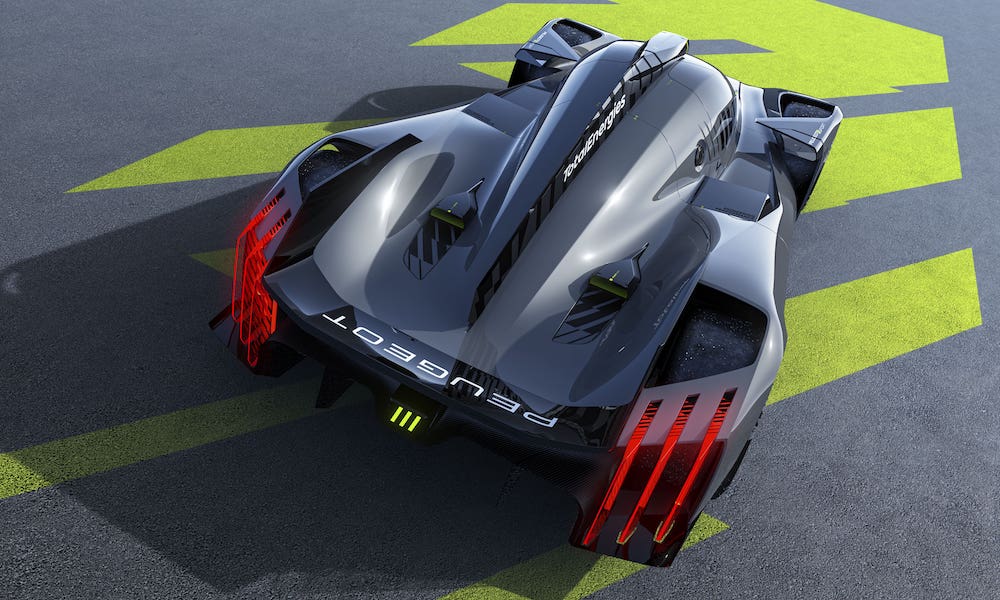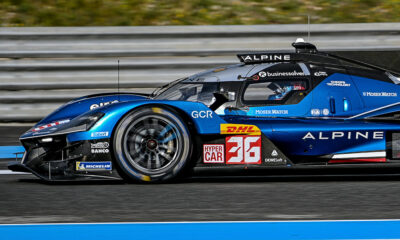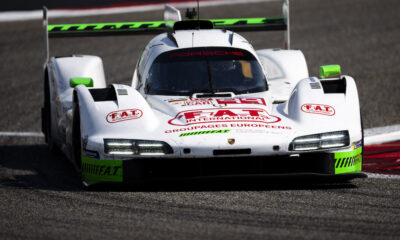Peugeot’s FIA World Endurance Championship technical director has explained why the manufacturer chose to uniquely design its 9X8 Le Mans Hypercar without a rear wing.
Olivier Jansonnie told reporters after the car’s reveal on Tuesday that Peugeot found it could achieve its desired performance levels even when it “put some new ideas on the table” by forgoing a traditional aerodynamic wing fixture at the back of the car.
He said that the “new opportunities” afforded by the LMH technical rules prompted Peugeot to try a radical wingless concept that turned out to be effective in simulations.
Article 3.4.1 of the LMH regulations states that each car is allowed to have one “adjustable aerodynamic device”, but it is not mandatory for this device to be a rear wing.
Peugeot’s striking car design, unveiled ahead of its WEC debut next year, marks a significant departure from those seen on the currently active Toyota GR010 Hybrid and Glickenhaus SCG 007, both of which feature wings on their single aero configurations.
“The LMH regulation is a completely new regulation,” said Jansonnie.
“It opens many new opportunities. We started from zero and we first spent quite some time reading the regulation carefully.
“We realized that we have a fixed target of downforce to achieve and we have the most complete freedom to do it, on the shape: more freedom than we had in the past.
“The combination of this fixed target and freedom, it makes you think and try to put some new ideas on the table. What we found, in the end, is that we can achieve a lot of performance required without the wing, basically.
“It’s not as simple as a design exercise. The car will very much look like it, at least proportionally and the concept is almost there.
“The car was exactly like that a few months ago when we had to freeze the concept.”
Rear wings provide race cars with downforce, pushing the vehicle onto the track surface. The absence of this feature on the 9X8 led Peugeot to design other parts of the car in specific ways to ensure that enough downforce is generated for WEC races.
Jansonnie explained that Peugeot is working out how to incorporate adjustable aero on the car’s bodywork. The team plans to try out “options” for this during its track test phase, which is due to start in December.
He also indicated that one important consideration during the Peugeot 9X8’s design period was how to manage the car’s aero balance without a conventional rear wing.
“That was actually the key thing in the decision not to use a rear wing: to find something to replace the rear wing, not in terms of overall performance but in terms of balance adjustments,” he said.
“We have a couple of ideas which we need to develop on track. That part of the development is very sensitive to track testing so that means we have some options for this on the bodywork, which would be not on the wing but on the bodywork.
“The opportunity of using the bodywork differently [is] for this [LMH] regulation. The regulation is a lot less restrictive on the shape of the underfloor. Even the rear car bodywork is also worked out in a different manner. That’s how we achieved it.”
Jansonnie added that Peugeot’s team is “confident” that its interpretation of the LMH rules will be competitive as well as ground-breaking, despite a lack of track testing so far.
“Clearly we designed this car with the firm intention to win Le Mans,” he said.
“We haven’t taken any risks, especially on the rear wing. We put together all the results from the wind tunnel and simulation we’ve done in the last months.
“But we have to keep a little bit of humility because we haven’t run this car on track yet.
“So far, from everything [we’ve seen], we’re confident. It doesn’t mean we are sure. But we are really confident.”
Peugeot Enjoying “Clean Sheet” Starting Point
Jean-Marc Finot, the head of the Stellantis Motorsport umbrella which includes Peugeot’s WEC program, explained that the manufacturer was able to design its hybrid LMH racer “from a clean sheet” and that this approach has proven beneficial so far.
Peugeot’s last endurance racing program with the 24 Hours of Le Mans-winning 908 LMP1 range ended in 2011.
The decade-long gap between then and now, which included the rise and fall of the hybrid LMP1 era, enabled Peugeot to approach the 9X8 with a clean break from its last Le Mans prototype.
“With very open regulations like these, you can bring some innovation that you would never get with usual regulations, with certain designs that have to be respected,” said Finot.
“I think the good thing is that we were able to start with a clean sheet, whereas Toyota, having been racing in LMP1 for a long time, had some modules to carry over and also a way of thinking from LMP1.
“That is not a negative: of course, I would like to have some technical bricks from LMP1, too!
“Also, we have to build our experience in endurance racing, because we are facing competitors who have been in endurance for 10, 12 or 70 years and have an according experience, so that is why we are still very modest.”
Rene de Boer contributed to this report.


























